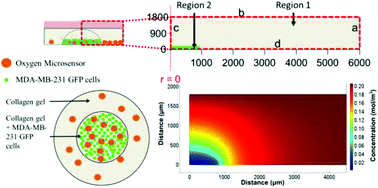当前位置:
X-MOL 学术
›
Biomater. Sci.
›
论文详情
Our official English website, www.x-mol.net, welcomes your
feedback! (Note: you will need to create a separate account there.)
Dispersible oxygen microsensors map oxygen gradients in three-dimensional cell cultures
Biomaterials Science ( IF 5.8 ) Pub Date : 2017-06-12 00:00:00 , DOI: 10.1039/c7bm00119c Sasha Cai Lesher-Pérez 1 , Ge-Ah Kim , Chuan-Hsien Kuo , Brendan M Leung , Sanda Mong , Taisuke Kojima , Christopher Moraes , M D Thouless , Gary D Luker , Shuichi Takayama
Biomaterials Science ( IF 5.8 ) Pub Date : 2017-06-12 00:00:00 , DOI: 10.1039/c7bm00119c Sasha Cai Lesher-Pérez 1 , Ge-Ah Kim , Chuan-Hsien Kuo , Brendan M Leung , Sanda Mong , Taisuke Kojima , Christopher Moraes , M D Thouless , Gary D Luker , Shuichi Takayama
Affiliation

|
Phase fluorimetry, unlike the more commonly used intensity-based measurement, is not affected by differences in light paths from culture vessels or by optical attenuation through dense 3D cell cultures and hydrogels thereby minimizing dependence on signal intensity for accurate measurements. This work describes the use of phase fluorimetry on oxygen-sensor microbeads to perform oxygen measurements in different microtissue culture environments. In one example, cell spheroids were observed to deplete oxygen from the cell-culture medium filling the bottom of conventional microwells within minutes, whereas oxygen concentrations remained close to ambient levels for several days in hanging-drop cultures. By dispersing multiple oxygen microsensors in cell-laden hydrogels, we also mapped cell-generated oxygen gradients. The spatial oxygen mapping was sufficiently precise to enable the use of computational models of oxygen diffusion and uptake to give estimates of the cellular oxygen uptake rate and the half-saturation constant. The results show the importance of integrated design and analysis of 3D cell cultures from both biomaterial and oxygen supply aspects. While this paper specifically tests spheroids and cell-laden gel cultures, the described methods should be useful for measuring pericellular oxygen concentrations in a variety of biomaterials and culture formats.
中文翻译:

分散式氧微传感器绘制三维细胞培养物中的氧梯度
与更常用的基于强度的测量不同,相位荧光测定法不受培养容器光路差异或密集 3D 细胞培养物和水凝胶的光学衰减的影响,从而最大限度地减少对信号强度的依赖,以实现准确测量。这项工作描述了在氧传感器微珠上使用相位荧光测定法在不同的微组织培养环境中进行氧测量。在一个例子中,观察到细胞球体在几分钟内耗尽了填充传统微孔底部的细胞培养基中的氧气,而在悬滴培养物中,氧浓度在数天内仍保持接近环境水平。通过将多个氧气微传感器分散在充满细胞的水凝胶中,我们还绘制了细胞产生的氧气梯度。空间氧映射足够精确,可以使用氧扩散和吸收的计算模型来估计细胞氧吸收率和半饱和常数。结果表明,从生物材料和供氧方面综合设计和分析 3D 细胞培养物的重要性。虽然本文专门测试了球体和充满细胞的凝胶培养物,但所描述的方法对于测量各种生物材料和培养形式中的细胞周氧浓度应该有用。
更新日期:2017-08-14
中文翻译:

分散式氧微传感器绘制三维细胞培养物中的氧梯度
与更常用的基于强度的测量不同,相位荧光测定法不受培养容器光路差异或密集 3D 细胞培养物和水凝胶的光学衰减的影响,从而最大限度地减少对信号强度的依赖,以实现准确测量。这项工作描述了在氧传感器微珠上使用相位荧光测定法在不同的微组织培养环境中进行氧测量。在一个例子中,观察到细胞球体在几分钟内耗尽了填充传统微孔底部的细胞培养基中的氧气,而在悬滴培养物中,氧浓度在数天内仍保持接近环境水平。通过将多个氧气微传感器分散在充满细胞的水凝胶中,我们还绘制了细胞产生的氧气梯度。空间氧映射足够精确,可以使用氧扩散和吸收的计算模型来估计细胞氧吸收率和半饱和常数。结果表明,从生物材料和供氧方面综合设计和分析 3D 细胞培养物的重要性。虽然本文专门测试了球体和充满细胞的凝胶培养物,但所描述的方法对于测量各种生物材料和培养形式中的细胞周氧浓度应该有用。











































 京公网安备 11010802027423号
京公网安备 11010802027423号